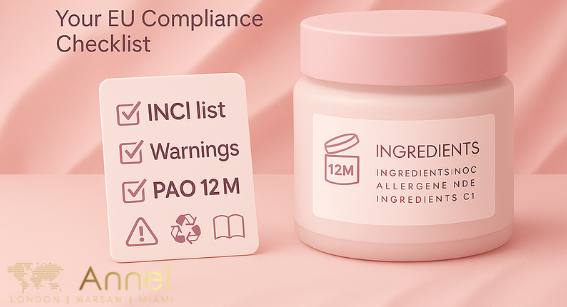Annel Regulatory Compliance & Responsible Person services in the UK, EU & USA. Ensure safety, meet legal standards & expand globally with Annel!
Cosmetic products compliance consultants.
The Most Common Labelling Mistakes in Cosmetics – and How to Avoid Them

Cosmetic labelling in the European Union is not merely a formality – it is a legal requirement for placing products on the market. Regulation (EC) No 1223/2009 clearly sets out what must appear on every package, and non-compliance can result in shipments being stopped, financial penalties, or even product recalls.
💡 Note: Similar requirements also apply in the UK under the UK Cosmetics Regulation (Schedule 34 of the Product Safety and Metrology Statutory Instrument 2019).
In this article, we cover:
• the mandatory elements of a cosmetic label,
• the most common mistakes companies make,
• how to avoid them using a practical checklist,
• and the latest regulatory changes coming into force in 2025.
Why is labelling so important?
For consumers, the label is the first source of information about a product – its function, composition, and safety. For authorities, it is the basis for verifying compliance with EU and UK law. Even one missing indication can block an entire shipment.
The most common mistakes in cosmetic labelling:
- Missing full details of the Responsible Person
Many companies forget to include the complete address, and for imports, the country of origin is also mandatory.
- Incorrect durability marking
A frequent error is the misuse of the PAO symbol and the expiry date. Remember:
• up to 30 months’ durability → mandatory best before end date (BBE),
• over 30 months’ durability → mandatory PAO symbol.
- Undeclared fragrance allergens
Since 2023, the list of allergens has been significantly expanded. However, the new extended list will only become mandatory from 2027 onwards. Until then, companies may still use the “old” list – but should start preparing now, as transition deadlines (2027/2028) are approaching.
- Missing translations
Mandatory information such as the function of the product, warnings, or shelf-life must always appear in the official language of the country of sale.
- Missing batch number
Sometimes the batch number is only placed on the carton, whereas it must also be on the unit packaging (unless this is technically impossible).
- Poor legibility and missing symbols
Fonts that are too small, poor contrast, or omitting the “book” symbol when transferring warnings to a leaflet – these are typical mistakes that undermine compliance.
- Lack of environmental markings
Several EU countries require material identification codes for packaging (e.g. PET, PP). Their absence can lead to local sanctions.
How to avoid mistakes? – Labelling checklist
Here is a practical checklist before printing:
Responsible Person details and country of origin (for imports)
Nominal content (g/ml)
Expiry date or PAO + correct symbol
Warnings and precautions (in the local language)
Batch number on the packaging
Product function (if not obvious)
INCI list: order, allergens, [nano], CI colourants
Updated allergens list – plan for EU 2023/1545 compliance (mandatory from 2027)
Language version consistent with the target market
Environmental markings and locally required symbols

New regulatory changes to be aware of
- Fragrance allergens (EU 2023/1545): extended list, mandatory labelling from 2027/2028.
- Online sales (GPSR 2023/988): from December 2024, all mandatory information must be available to consumers prior to purchase.
- Wet wipes (SUPD 2019/904): mandatory symbol “do not flush, contains plastic”.
- Aerosols (ADD 75/324/EEC): additional warnings relating to pressure and flammability.
Conclusion
The most common cosmetic labelling mistakes stem from seemingly minor oversights – missing translations, skipped symbols, outdated allergen lists. Yet each of them can have serious business consequences.
That is why using a checklist and staying up to date with regulatory changes is crucial.
👉 If you want to ensure your brand’s labels are fully compliant, contact the Annel team – we will guide you through the process step by step.
